Yet another camera for Rob
/This is the first picture I took… I think we are going to get along fine
Whisper it, I’ve bought another camera. It seems that I’m slowly converting all my music production devices into cameras. This was our first trip to York since before the pandemic. Last time we went I wandered into York Camera Mart and bought a lens. This time I’ve got a camera, for around the same price. It is a very old camera, but I really like the way it looks and how nice it is to operate.
When we got back home I processed the film and took at the negatives. Every time you take a picture on a film camera you are setting yourself up for a little bit of heartbreak when the developed version fails to match up to the lovely image in the viewfinder. This is especially true when you take black and white pictures. Things with different colours might map to exactly the same shade of grey and disappear into each other. I’m very happy with the shots that I got though. I need to work on my exposure technique - quite a few shots were over-exposed - but I’m very happy to do this because the camera itself is just so much fun to use. And now I’m going to sell another synthesizer….


































